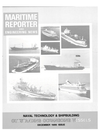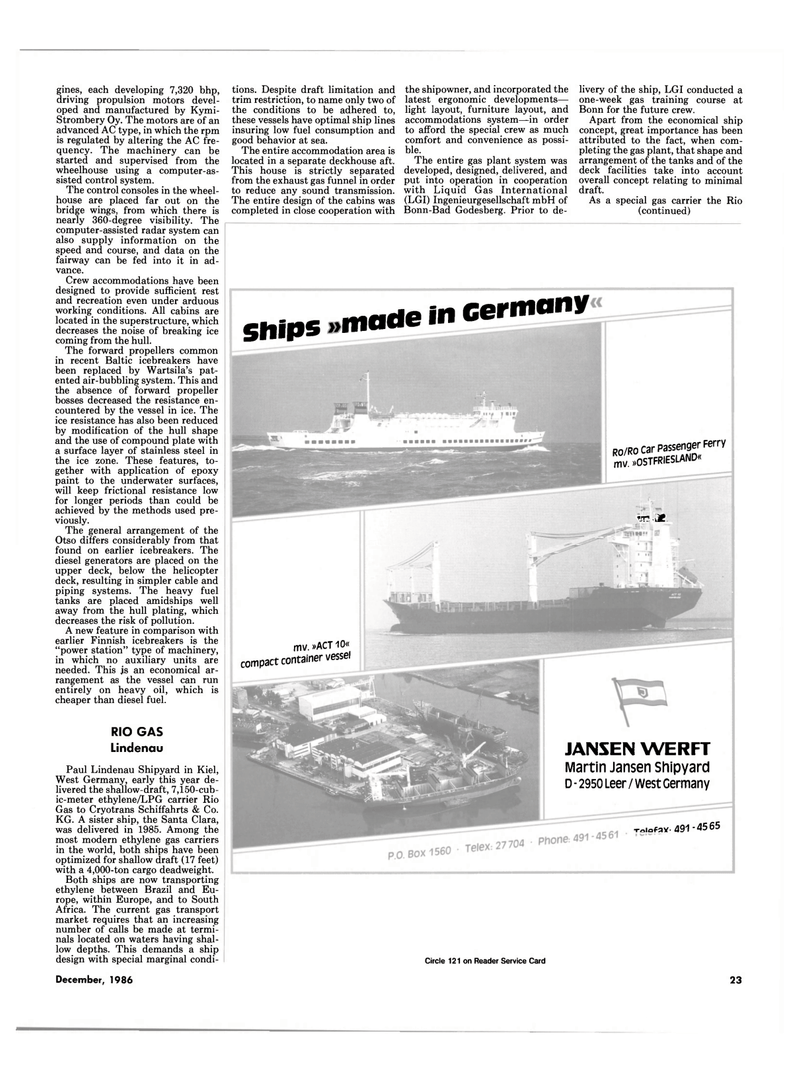
Page 21: of Maritime Reporter Magazine (December 1986)
Read this page in Pdf, Flash or Html5 edition of December 1986 Maritime Reporter Magazine
gines, each developing 7,320 bhp, driving propulsion motors devel- oped and manufactured by Kymi-
Strombery Oy. The motors are of an advanced AC type, in which the rpm is regulated by altering the AC fre- quency. The machinery can be started and supervised from the wheelhouse using a computer-as- sisted control system.
The control consoles in the wheel- house are placed far out on the bridge wings, from which there is nearly 360-degree visibility. The computer-assisted radar system can also supply information on the speed and course, and data on the fairway can be fed into it in ad- vance.
Crew accommodations have been designed to provide sufficient rest and recreation even under arduous working conditions. All cabins are located in the superstructure, which decreases the noise of breaking ice coming from the hull.
The forward propellers common in recent Baltic icebreakers have been replaced by Wartsila's pat- ented air-bubbling system. This and the absence of forward propeller bosses decreased the resistance en- countered by the vessel in ice. The ice resistance has also been reduced by modification of the hull shape and the use of compound plate with a surface layer of stainless steel in the ice zone. These features, to- gether with application of epoxy paint to the underwater surfaces, will keep frictional resistance low for longer periods than could be achieved by the methods used pre- viously.
The general arrangement of the
Otso differs considerably from that found on earlier icebreakers. The diesel generators are placed on the upper deck, below the helicopter deck, resulting in simpler cable and piping systems. The heavy fuel tanks are placed amidships well away from the hull plating, which decreases the risk of pollution.
A new feature in comparison with earlier Finnish icebreakers is the "power station" type of machinery, in which no auxiliary units are needed. This js an economical ar- rangement as the vessel can run entirely on heavy oil, which is cheaper than diesel fuel.
RIO GAS
Lindenau
Paul Lindenau Shipyard in Kiel,
West Germany, early this year de- livered the shallow-draft, 7,150-cub- ic-meter ethylene/LPG carrier Rio
Gas to Cryotrans Schiffahrts & Co.
KG. A sister ship, the Santa Clara, was delivered in 1985. Among the most modern ethylene gas carriers in the world, both ships have been optimized for shallow draft (17 feet) with a 4,000-ton cargo deadweight.
Both ships are now transporting ethylene between Brazil and Eu- rope, within Europe, and to South
Africa. The current gas transport market requires that an increasing number of calls be made at termi- nals located on waters having shal- low depths. This demands a ship design with special marginal condi- tions. Despite draft limitation and trim restriction, to name only two of the conditions to be adhered to, these vessels have optimal ship lines insuring low fuel consumption and good behavior at sea.
The entire accommodation area is located in a separate deckhouse aft.
This house is strictly separated from the exhaust gas funnel in order to reduce any sound transmission.
The entire design of the cabins was completed in close cooperation with the shipowner, and incorporated the latest ergonomic developments— light layout, furniture layout, and accommodations system—in order to afford the special crew as much comfort and convenience as possi- ble.
The entire gas plant system was developed, designed, delivered, and put into operation in cooperation with Liquid Gas International (LGI) Ingenieurgesellschaft mbH of
Bonn-Bad Godesberg. Prior to de- livery of the ship, LGI conducted a one-week gas training course at
Bonn for the future crew.
Apart from the economical ship concept, great importance has been attributed to the fact, when com- pleting the gas plant, that shape and arrangement of the tanks and of the deck facilities take into account overall concept relating to minimal draft.
As a special gas carrier the Rio (continued)
Circle 121 on Reader Service Card
Ships made in Germany »
RO/RO car passenger Ferry mv »OSTFRIESLAND« rn "X mv. »ACT 10« compact container vessel
JANSEN WERFT
Martin Jansen Shipyard
D - 2950 Leer / west Germany -r„iofay- <391 -4565
December, 1986 23

 20
20

 22
22
